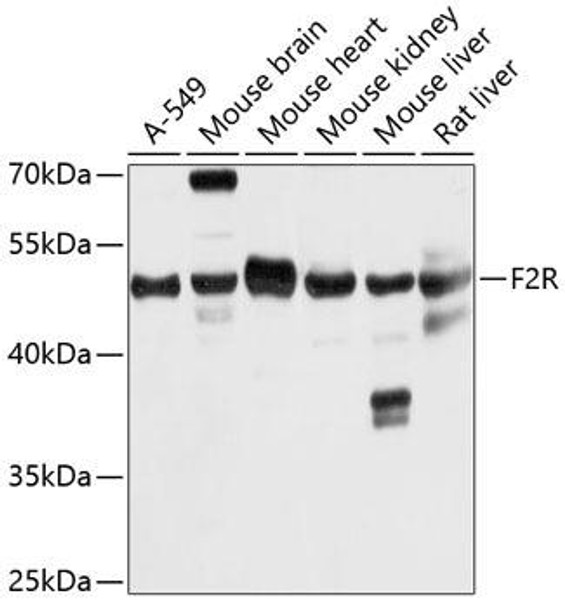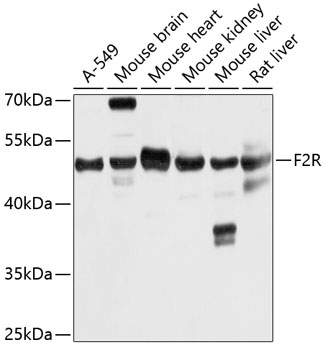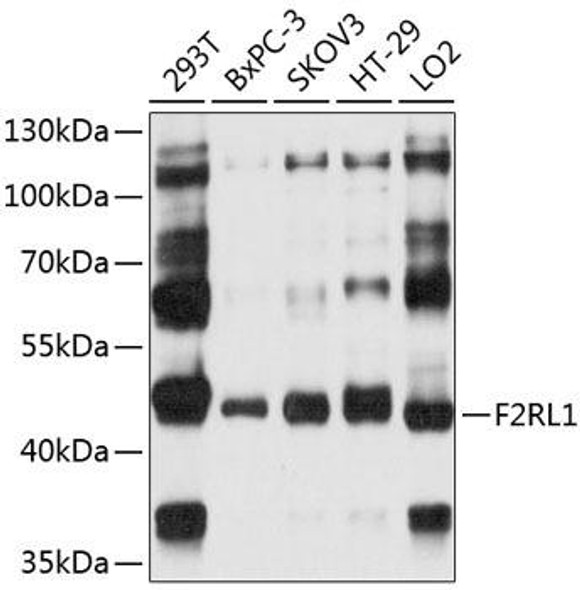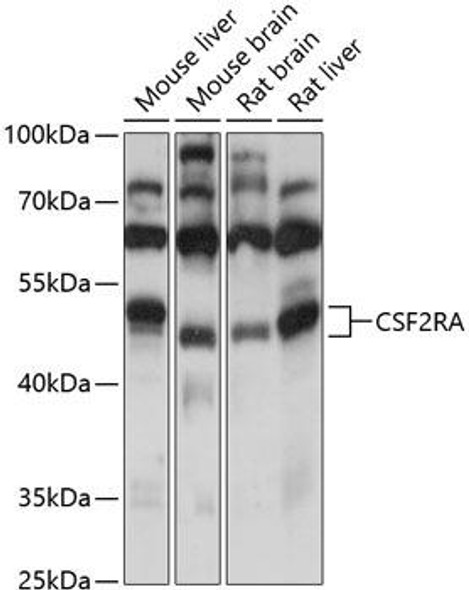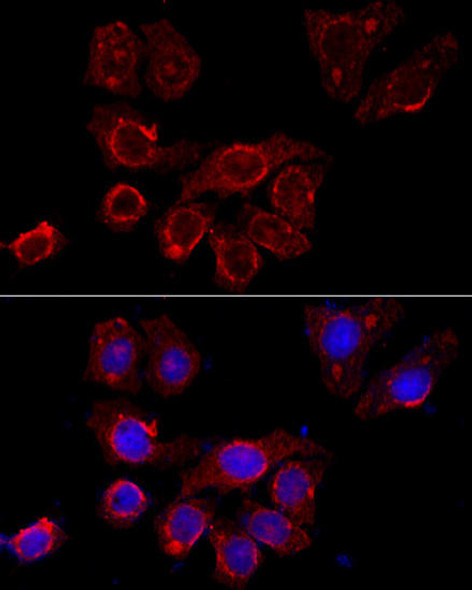Cardiovascular Antibodies
Anti-F2R Antibody (CAB5641)
- SKU:
- CAB5641
- Product Type:
- Antibody
- Reactivity:
- Human
- Reactivity:
- Mouse
- Reactivity:
- Rat
- Host Species:
- Rabbit
- Isotype:
- IgG
- Antibody Type:
- Polyclonal Antibody
- Research Area:
- Cardiovascular
Description
| Antibody Name: | Anti-F2R Antibody |
| Antibody SKU: | CAB5641 |
| Antibody Size: | 20uL, 50uL, 100uL |
| Application: | WB |
| Reactivity: | Human, Mouse, Rat |
| Host Species: | Rabbit |
| Immunogen: | Recombinant fusion protein containing a sequence corresponding to amino acids 42-110 of human F2R (NP_001983.2). |
| Application: | WB |
| Recommended Dilution: | WB 1:500 - 1:2000 |
| Reactivity: | Human, Mouse, Rat |
| Positive Samples: | A-549, Mouse brain, Mouse heart, Mouse kidney, Mouse liver, Rat liver |
| Immunogen: | Recombinant fusion protein containing a sequence corresponding to amino acids 42-110 of human F2R (NP_001983.2). |
| Purification Method: | Affinity purification |
| Storage Buffer: | Store at -20'C. Avoid freeze / thaw cycles. Buffer: PBS with 0.02% sodium azide, 50% glycerol, pH7.3. |
| Isotype: | IgG |
| Sequence: | SFLL RNPN DKYE PFWE DEEK NESG LTEY RLVS INKS SPLQ KQLP AFIS EDAS GYLT SSWL TLFV PSVY T |
| Gene ID: | 2149 |
| Uniprot: | P25116 |
| Cellular Location: | Cell membrane, Multi-pass membrane protein |
| Calculated MW: | 47kDa |
| Observed MW: | 47kDa |
| Synonyms: | F2R, CF2R, HTR, PAR-1, PAR1, TR |
| Background: | Coagulation factor II receptor is a 7-transmembrane receptor involved in the regulation of thrombotic response. Proteolytic cleavage leads to the activation of the receptor. F2R is a G-protein coupled receptor family member. Alternative splicing results in multiple transcript variants. |
| UniProt Protein Function: | PAR1: a G-protein coupled high-affinity receptor for activated thrombin or trypsin. Coupled to G proteins that stimulate phosphoinositide hydrolysis. Coupled to G proteins that stimulate phosphoinositide hydrolysis. May play a role in platelet activation and in vascular development. |
| UniProt Protein Details: | Protein type:GPCR, family 1; Membrane protein, multi-pass; Membrane protein, integral; Receptor, GPCR; Cell development/differentiation Chromosomal Location of Human Ortholog: 5q13 Cellular Component: Golgi apparatus; postsynaptic membrane; integral to plasma membrane; early endosome; plasma membrane; extracellular region; caveola; neuromuscular junction Molecular Function:G-protein coupled receptor activity; protein binding; G-protein beta-subunit binding; G-protein alpha-subunit binding; thrombin receptor activity; receptor binding Biological Process: elevation of cytosolic calcium ion concentration during G-protein signaling, coupled to IP3 second messenger (phospholipase C activating); positive regulation of blood coagulation; activation of MAPKK activity; negative regulation of glomerular filtration; positive regulation of transcription, DNA-dependent; positive regulation of collagen biosynthetic process; positive regulation of JAK-STAT cascade; positive regulation of caspase activity; response to lipopolysaccharide; negative regulation of cell proliferation; elevation of cytosolic calcium ion concentration; connective tissue replacement during inflammatory response; positive regulation of MAPKKK cascade; platelet dense granule organization and biogenesis; regulation of interleukin-1 beta production; protein kinase C activation; positive regulation of cell proliferation; response to wounding; positive regulation of smooth muscle contraction; negative regulation of neuron apoptosis; establishment of synaptic specificity at neuromuscular junction; inflammatory response; STAT protein nuclear translocation; caspase activation; platelet activation; anatomical structure morphogenesis; positive regulation of I-kappaB kinase/NF-kappaB cascade; positive regulation of Rho protein signal transduction; positive regulation of phosphoinositide 3-kinase cascade; tyrosine phosphorylation of STAT protein; G-protein coupled receptor protein signaling pathway; homeostasis of number of cells within a tissue; release of sequestered calcium ion into cytosol; regulation of blood coagulation; positive regulation of vasoconstriction; G-protein signaling, coupled to IP3 second messenger (phospholipase C activating); regulation of sensory perception of pain; positive regulation of release of sequestered calcium ion into cytosol; positive regulation of calcium ion transport; blood coagulation; positive regulation of cell migration |
| NCBI Summary: | Coagulation factor II receptor is a 7-transmembrane receptor involved in the regulation of thrombotic response. Proteolytic cleavage leads to the activation of the receptor. F2R is a G-protein coupled receptor family member. [provided by RefSeq, Jul 2008] |
| UniProt Code: | P25116 |
| NCBI GenInfo Identifier: | 20178318 |
| NCBI Gene ID: | 2149 |
| NCBI Accession: | P25116.2 |
| UniProt Secondary Accession: | P25116,Q53XV0, Q96RF7, Q9BUN4, |
| UniProt Related Accession: | P25116 |
| Molecular Weight: | Calculated: 47kDaObserved: 47kDa |
| NCBI Full Name: | Proteinase-activated receptor 1 |
| NCBI Synonym Full Names: | coagulation factor II (thrombin) receptor |
| NCBI Official Symbol: | F2R |
| NCBI Official Synonym Symbols: | TR; HTR; CF2R; PAR1; PAR-1 |
| NCBI Protein Information: | proteinase-activated receptor 1; protease-activated receptor 1 |
| UniProt Protein Name: | Proteinase-activated receptor 1 |
| UniProt Synonym Protein Names: | Coagulation factor II receptor; Thrombin receptor |
| Protein Family: | Proteinase-activated receptor |
| UniProt Gene Name: | F2R |
| UniProt Entry Name: | PAR1_HUMAN |

